For English version please scroll down
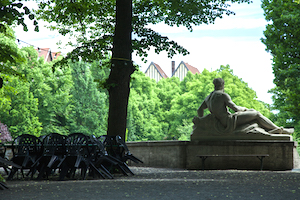
Rüdesheimer Platz
Foto: Jordana Schramm
Es ist schon amüsant, aus der New York Times zu erfahren, dass ich in einem der schönsten Kieze der Welt wohne, der Gegend rund um den Rüdesheimer Platz nämlich, in Charlottenburg-Wilmersdorf, mitten im alten Westen. „Da bin ich auf dem Weg zur Freien Universität tatsächlich nie ausgestiegen“, sagt eine junge Studentin aus Schweden. Sie hatte mich gefragt, wo ich wohne, und die Antwort machte mich sogleich um einiges interessanter.
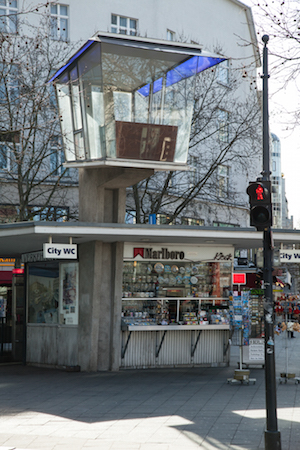
West-Berlin
Foto: Jordana Schramm
Die letzten 25 Jahre bekam ich auf die gleiche Antwort bestenfalls mitleidige, meistens gelangweilte Blicke. Wilmersdorf? Charlottenburg? Where the fuck is this? Who fucking cares? Prenzlauer Berg, Mitte, in den letzten Jahren Kreuzberg, besser noch Kreuzkölln, damit war zu beeindrucken.
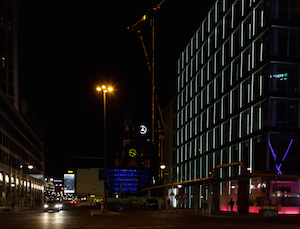
West-Berlin
Foto: Jordana Schramm
Um ganz ehrlich zu sein, es ist nicht zu erwarten, dass die hippe Crowd nun hierher, zu mir, pilgert. Charlottenburg-Wilmersdorf und die angrenzenden Bezirke sind bürgerliche Wohngegenden, waren nie so preiswert wie Prenzlauer Berg vor der Eroberung, oder auch Kreuzberg, erst recht Neukölln. In Neukölln wollte früher nie jemand wohnen, in Charlottenburg-Wilmersdorf zumindest alle, die sich auskannten und nicht vor der Haustür einen Club brauchten, schon immer.
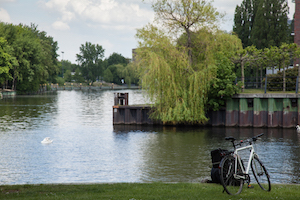
West-Berlin
Foto: Jordana Schramm
Der alte Westen ist das, was Berlin vor dem Mauerfall noch am ähnlichsten sieht. Hier störte nie die Mauer den Blick nach drüben, hier war man zuhause und konnte vergessen, dass man in einer eingeschlossenen Stadt lebte. Wenn heute Gäste zum ersten Mal zu mir zu Besuch kommen, sind sie oft zu früh. „Ich dachte, das wäre viel weiter draußen“.
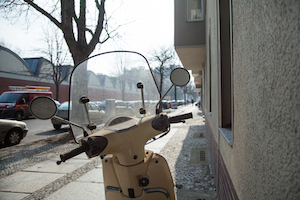
West-Berlin
Foto: Jordana Schramm
In zwanzig Minuten in den Dschungel
Tatsächlich konnte ich vom „Rüdesheimer-Platz-Kiez“ in gut 20 Minuten zum Dschungel in der Nürnberger Straße laufen. David Bowie, Zazie de Paris, Nick Cave, Romy Haag, Salomé, Martin Kippenberger, Iggy Pop und viele der anderen bunten Gestalten des Berliner Nachtlebens trafen sich hier in den 80er Jahren in dem inzwischen legendären Club mit Aquarium und Springbrunnen, tranken Gin Fizz, tanzten und stellten sich vor allen Dingen auch selbst zu Schau.
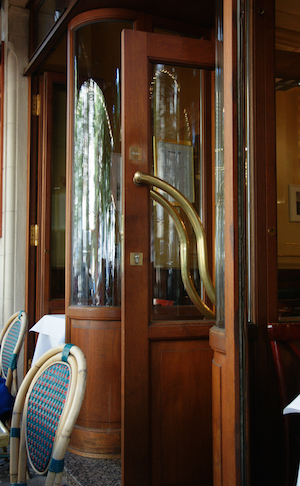
West-Berlin
Foto: Jordana Schramm
Die Modeschüler und Schülerinnen des Lette-Vereins nähten vor jedem Besuch noch bis spät in die Nacht neue Klamotten, Jacken mit breiten Schultern, Reiterhosen, Pierrot-Kostüme und nachdem sich Werner erst mal entschieden hatte, als Dame zu erscheinen, musste er/sie sich natürlich jeden Abend selber überbieten: Er erschien als Geisha, als Leoparden-Domina, als Disco-Girl … Gender war damals übrigens noch kein geläufiger Begriff. Es gab auch weder H&M noch Zara, kein Mango oder gar Cheap Monday. Es wurde genäht, umgearbeitet und drapiert, um auf den Bühnen des Nachtlebens aufzufallen.
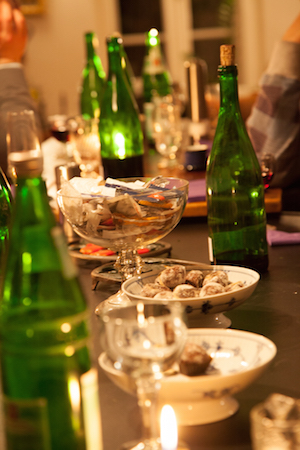
West-Berlin
Foto: Jordana Schramm
Das fand im Wesentlichen in den Seitenstraßen des Kurfürstendamms statt. Heute kaum noch vorstellbar. Linientreu, Vitamin C Intensivstation, Damaschke Night Club hießen die New-Wave-Clubs, Madow, Sugar Shack oder Valentino die Popper-Discos. Punkiger ging es in Kreuzberg zu, genauer im SO36, in der O-Bar und im gleichnamigen Club SO36.
Der alte bürgerliche Westen war ein Lebensgefühl und eine bestimmte Ästhetik. Damals waren Labels noch nicht so wichtig, lange gab es nur zwei, drei Geschäfte mit wirklicher Designermode, Kramberg brachte Armani, Versace, Valentino nach Berlin und bot den Kollektionen am oberen Ende des Kurfürstendamms im weißgekachelten Geschäft das angemessene Ambiente.
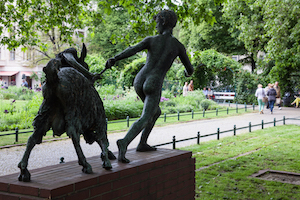
West-Berlin
Foto: Jordana Schramm
Damals eine Sensation. Bei Moosgrund, dem kleinen Geschäft in der Bleibtreustraße mit dem Baumsteg in der Mitte, kauften Architektinnen Kenzo und Issey Miyake. Die Premieren der Schaubühne am Lehniner Platz waren Gelegenheiten, die Kleider auszuführen, das Jazz Fest oder die Theaterfestspiele andere gesellschaftliche Ereignisse. In der Philharmonie, Karajan stand noch am Pult, traf sich das ganze bürgerlich-bourgeoise Berlin. Generell galten aber Statussymbole in Berlin nicht allzu viel. Man protzte hier eher nicht, und allzu viel Reichtum gab es ja ohnehin nicht. Ihn zu zeigen war vulgär. Berlin war eine Stadt der Kunst, des Theaters, klar: hochsubventioniert natürlich, aber es hat sich gelohnt.
Westberliner betrachteten von Charlottenburg-Wilmersdorf die Veränderungen aus der Distanz
In den großen großbürgerlichen Wohnungen etwa rund um den Savignyplatz lebte es sich damals (wie heute) bequem, weiter im Südwesten in Grunewald, Dahlem, Zehlendorf sowieso. Und nichts war wirklich ganz weit weg. Wannsee vielleicht. Kreuzberg und Neukölln, heute Hipsterplätze, waren für Outlaws, Schöneberg für die alternative Szene. Das jetzt wieder so ins Gespräch gekommene Charlottenburg mit seinem Unterbezirk Wilmersdorf ist so attraktiv, weil so unspektakulär.
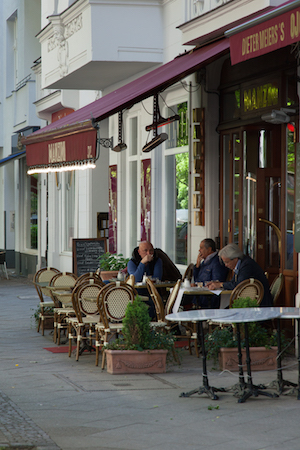
West-Berlin
Foto: Jordana Schramm
Es wirkt so beruhigend unaufgeregt in aufgeregten Zeiten. Hier ist Berlin grün, die Häuser gepflegt, hier gibt es Platz und auf dem Spielplatz finden sich keine Spritzen. Ein bisschen ist das Leben hier, wie es mal war. Der alte Westen kann nicht gentrifiziert werden, er war es schon immer. Er kann nur mit neuen Augen betrachtet werden. Weniger aufgeregt als der Osten, in dem sich alles veränderte, wo eine neue Stadt entstand, die mit der alten rein gar nichts mehr zu tun hat. Zum Glück, möchte man sagen. Ostberlin war nach dem Mauerfall kurz davor zusammenzufallen, es wirkte in einigen Teilen so, als sei der Zweite Weltkrieg gerade erst vorbei, so grau, so kaputt. Es war auf keinen Fall der Ort, an dem wir Westberliner leben wollten. Für die Neuberliner spielte hier das Leben, war der Puls der Zeit spürbar. Wir betrachteten von Charlottenburg-Wilmersdorf die Veränderungen lieber aus der Distanz. Ich erinnere mich genau, dass es in den ersten Jahren nach dem Mauerfall in Mitte, geschweige denn anderswo, kein Café gab, in das man hätte gehen können. Kein Licht, keine Lichtreklame, kein Restaurant. Geschäfte jeder Art? Fehlanzeige! Ich war fasziniert vom Neuen, das da entstand, von den Bars, Restaurant und Clubs, und doch ohne jede Sehnsucht, dort hinzuziehen. Unser Leben im Westen ging ja weiter.
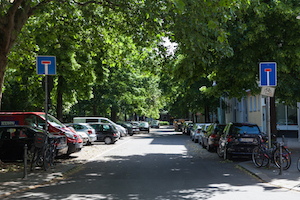
West-Berlin
Foto: Jordana Schramm
Der Ausflugsradius wurde nur größer. Wir bekamen quasi eine zweite Stadt geschenkt. Für mich ging ein Traum in Erfüllung. Dass mich Neuberliner zweimal fragten: „Wo wohnst Du? Wirklich? Nie gehört“, war kein Problem. Das scheint sich zu ändern. Die ganz anders gearteten Qualitäten des Berliner Westens werden jetzt entdeckt. Es kann nichts schaden, wenn auch hier ein wenig neuer Wind reinbläst, ein neues Berlin braucht es hier aber bitte nicht. Der alte Westen ist lebendig, auf ganz andere Art und Weise als der „neue“ Osten. Beides braucht eine Stadt von Welt.
Zu dem Thema lesen Sie auch: Charlottenburger Kiez – Lieblingsplätze
The Old West
It is pretty amusing to read in the New York Times that I happen to live in one of the nicest districts in the world, that is, the area around Rüdesheimer Platz in Charlottenburg-Wilmersdorf, in the middle of the old West. “I’ve never actually stopped there on my way to the Freie Universität,” says a young student from Sweden. She had just asked me where I lived, and my answer had immediately made me quite a bit more interesting. For the past 25 years the same answer has landed me at best with sympathetic looks, but mostly with bored stares. Wilmersdorf? Charlottenburg? Where the fuck is this? Who fucking cares? Prenzlauer Berg, Mitte, in recent years Kreuzberg, even better Kreuzkölln, that was what would impress people. To be totally honest, the hip crowd can’t be expected to migrate over here to me. Charlottenburg-Wilmersdorf and the neighbouring districts are middle-class residential areas, and were never as cheap as Prenzlauer Berg before the post-Wall invasion, or even Kreuzberg, not to mention Neukölln. Beforehand nobody wanted to live in Neukölln, but everyone who doesn’t need a club right on their doorstep has always wanted to live in Charlottenburg-Wilmersdorf. This is the old West, which is the closest it gets to seeing what Berlin looked like before the fall of the Wall. Here, your view of the other side was never blocked by the Wall; here, you could feel at home and forget that you were living in a walled-in city. Nowadays when people come to visit me for the first time, they often turn up early. “I thought it was much further out.”
Twenty minutes walk to the Jungle
In fact, it used to only take me 20 minutes to walk from the Rüdesheimer Platz neighbourhood to the ‘Jungle’ on Nürnberger Strasse. During the 80s, the now legendary club called Dschungel (meaning jungle in German) with its aquarium and fountain was the stomping ground for David Bowie, Zazie de Paris, Nick Cave, Romy Haag, Salomé, Martin Kippenberger, Iggy Pop and many of the other glamorous figures of the Berlin nightlife, where they drank gin fizz, danced, and above all put themselves on show. Students from the fashion and design school, Lette Verein, bent over their sewing machines late into the night, working on new clothes, jackets with wide shoulders, skin-tight trousers, Pierrot outfits; and after Werner had decided to dress as a lady, of course he/she had to make each night’s outfit more dazzling than the last: he turned up as a geisha, a leopardess-dominatrix, a disco girl… Anyway, back then gender wasn’t a common term. There wasn’t H&M or Zara, no Mango or even Cheap Monday. People sewed, reworked and draped so that they would turn heads on the nightlife stage. Essentially this took place in the side streets of Kurfürstendamm. Today this is practically unimaginable. Linientreu, Vitamin C Intensivstation, and Damaschke Night Club were the new wave clubs, whilst Madow, Sugar Shack or Valentino were the pop discos. Things were a bit more punky in Kreuzberg, especially in the old south east postcode of SO36, the home of O-Bar and a club which was, of course, called SO36.
The old bourgeois West was a way of life and a certain aesthetic. In those days, labels hadn’t become so important, and for a long time there were only two or three shops with real designer wear. Kramberg brought Armani, Versace, and Valentino to Berlin and presented the collections on the upper end of Kurfürstendamm in the fitting ambience of a white-tiled store. That was a sensation back then. Moosgrund, the small boutique on tree-lined Bleibtreustrasse, was where architects bought Kenzo and Issey Miyake. The premiers at the Schaubühne theatre on Lehniner Platz were occasions to put on your best frocks, as well as the Jazz Fest, the performances at the Theaterfestspiele or other social events. At the Philharmonie, Karajan still held the conductor’s baton and the whole of bourgeois Berlin gathered there. But in general, status symbols did not count for much in Berlin. People didn’t really splurge here, and there wasn’t that much wealth around anyway. To show it off was vulgar. Berlin was a city of art, of theatre; highly subsidized of course, but it was worth it.
West Berliners in Charlottenburg-Wilmersdorf watched the changes from a distance
It was (and still is) a comfortable life in the large upper-class apartments around Savignyplatz and of course further south west in Grunewald, Dahlem, and Zehlendorf. And nothing was really that far away. Apart from Wannsee perhaps. Kreuzberg and Neukölln, today the hangouts of hipsters, were for outlaws, and Schöneberg was for the alternative scene. Charlottenburg with its neighbour Wilmersdorf, now coming back into conversation, are so attractive because they are not spectacular. They feel calmingly peaceful when times are hectic. This is the green side of Berlin, where the buildings are clean, there is space and there aren’t syringes lying around in the playgrounds. Life here is a bit like what it used to be. The old West cannot become gentrified, it always has been. It can only be viewed with new eyes. It is less crazy than the East, where everything changed, where a new city formed which has nothing to do with the old one. Thankfully, you might say. East Berlin after the fall of the Wall was close to collapse, and in some parts it felt as if the Second World War had just come to an end, it was so grey, so broken. It was definitely not the place where we West Berliners wanted to live. For newcomers to Berlin it was here that life was happening, where you could feel the spirit of the times. I still remember exactly how, in the first years after the fall of the Wall, there wasn’t a single café that you could go to in Mitte, never mind anywhere else. No lights, no neon signs, no restaurants. Shops of any kind? No chance! I was fascinated by the new things that emerged there, by the bars, restaurants and clubs, yet without any urge to move there. Our life in the West just went on. Except we had more options for places to go. It was as if we had been given a second city. For me it was like a dream come true. The fact that two new Berliners asked me, “Where do you live? Really? Never heard of it,” that wasn’t an issue. That seems to be changing. The completely different character of West Berlin is now being discovered. It can’t hurt to have a breath of fresh air blowing through here, but no new Berlin for the West, please. The old West is lively, in a completely different way to the “new” East. Both have what an international city needs.
To read more on this topic: Wilmersdorf-Charlottenburg – Squares to be
Rüdesheimer Platz is a pretty, quiet square, a good place to live with a decent infrastructure. Yet there are also other nice squares in Charlottenburg which you might be even more eager to explore.
Übersetzung: Rosalee Edwards
